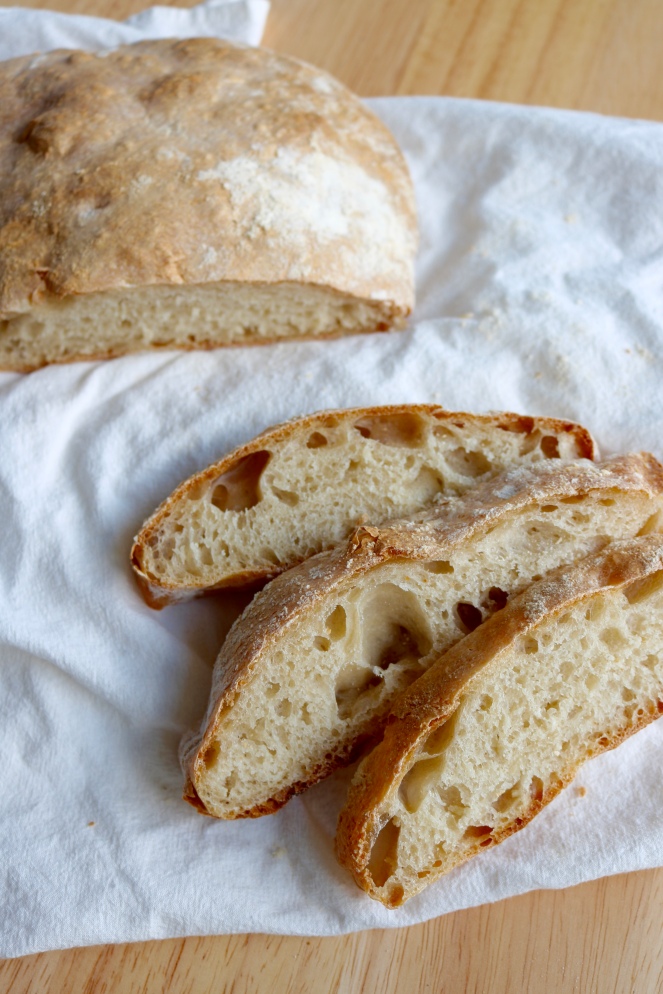
Happy December everyone! I’m currently in the midst of finals, but thought I would go ahead and get this post out, especially seeing as I took these pictures months ago. I’ve made this ciabatta a few times, and I’m a big fan. Ciabatta was also on my baking bucket list this year, so its nice to cross off another item. I’ve actually made all but one of the items on my list, but have yet to find suitable recipes for those that are left. Crossing my fingers that I’ll find time to get posts out for the remaining items in the couple of weeks after finals!
The ciabatta has a nice chewy texture and a great artisan flavor. It does take some forethought since the sponge needs to be made the day before, but the hands on time for the recipe is low. The one tip I will add is that a touch of additional flour may need to be added during the kneading stage. If the dough isn’t collecting on the paddle, it is too moist. I made this mistake once, and my ciabatta couldn’t fully hold its form and ended up a bit flat.

Recipe
Ingredients:
For the sponge:
1 cup all-purpose flour
⅛ tsp. instant yeast
½ cup water, at room temperature
For the dough:
2 cups all-purpose flour
1½ tsp. salt
½ tsp. instant yeast
¾ cup water, at room temperature
¼ cup whole or 2% milk, at room temperature
Directions:
1. Make the Sponge: Combine the flour, yeast and water in a medium bowl and stir with a wooden spoon until a uniform mass forms. Cover the bowl tightly with plastic wrap and let stand at room temperature for at least 8 hours or up to 24 hours.
2. Make the Dough: Place the sponge and remaining dough ingredients in the bowl of a stand mixer fitted with the paddle attachment. Mix on low speed until combined and a shaggy dough forms, about 1 minute, scraping down the bowl and paddle as needed. Increase the speed to medium-low and continue mixing until the dough becomes a uniform mass that collects on the paddle and pulls away from the sides of the bowl, 4 to 6 minutes.
3. Change to the dough hook and knead the bread on medium speed until smooth and shiny (the dough will be very sticky), about 10 minutes. Transfer the dough to a large bowl, cover tightly with plastic wrap, and let rise at room temperature until doubled in size, about 1 hour.
3. Spray a rubber spatula or bowl scraper with cooking spray. Fold the dough over itself by gently lifting and folding the edge of the dough toward the middle. Turn the bowl 90 degrees, and fold again. Turn the bowl and fold the dough 6 more times (for a total of 8 times). Cover with plastic wrap and let rise for 30 minutes.
4. Repeat the folding as in step #3, replace the plastic wrap, and let rise until doubled in size, about 30 minutes.
5. One hour before baking, adjust an oven rack to the lower-middle position, place a baking stone on the rack and preheat the oven to 450° F.
6. Prepare parchment paper to fit baking sheet or stone and dust liberally with flour. Transfer the dough to a floured work surface, being careful not to deflate it completely. Liberally flour the top of the dough and divide it in half with a bench scraper. Turn 1 piece of dough cut-side-up and dust with flour. With well-floured hands, press the dough into a rough 12×6-inch rectangle. Fold the shorter sides of the dough toward center, overlapping them like you would fold a letter in thirds, to form a 7×4-inch rectangle. Repeat with the second piece of dough.
7. Gently transfer each loaf, seam-side-down, to the parchment sheets, dust with flour, and cover with plastic wrap. Let the loaves sit at room temperature for 30 minutes.
8. Slide the parchment pieces with the loaves onto the baking sheet or stone. Using floured fingertips, evenly poke the entire surface of each loaf to form a 10×6-inch rectangle; spray the loaves lightly with water. Bake, spraying the loaves with water twice more during the first 5 minutes of baking time, until the crust is deep golden brown and the loaves register 210 degrees F, 22 to 27 minutes.
9. Transfer the loaves to a wire rack and let cool to room temperature for at least 1 hour before slicing and serving. The bread can be wrapped in a double layer of plastic wrap and stored at room temperature for up to 3 days. Wrapped with an additional layer of foil, the bread can be frozen for up to 1 month. To recrisp the crust, thaw the bread at room temperature (if frozen), and place unwrapped bread in 450-degree oven for 6 to 8 minutes.
Yield: 2 loaves
(Recipe from Cook’s Illustrated Baking Book)
love this post! great read
LikeLiked by 1 person
Love bread !!
LikeLike
Tasty, a lovely recipe indeed 😄
LikeLiked by 1 person